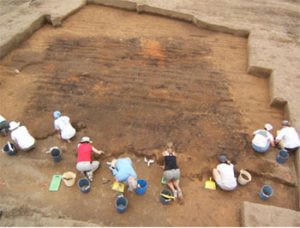
Excavation of a house at Joara
The Little Ice Age
The people who lived in the lower Mississippi valley (modern Louisiana, Mississippi and Alabama) were not doing so well around 1500 AD. The Little Ice Age of the 1400s, or some other crisis, had weakened their economic and political system. But they were farming corn and beans and living in towns. They were still trading all up and down the Mississippi River, and as far south as Central America.
The earlier Mississipians
The Mississippian period
More Native American articles
One big town, Joara, was at the base of the Appalachian Mountains (modern North Carolina). Another town, Yssa, was also in North Carolina. The whole Mississippi valley was divided into chiefdoms, with both men and women as chiefs. These chiefdoms were often at war with each other, or making treaties with each other.
What’s a chiefdom?
The Appalachian Mountains
Spanish explorers arrive
But then things got a lot worse. In 1528, the first Spanish explorer, Narvaez, met some Mississippian people, and then in 1539, another Spanish explorer, De Soto, came through the Mississippi Valley and left a fort near Joara in what is now North Carolina. After a year and a half, though, the people of Joara killed all of the men at De Soto’s fort.

Hernando De Soto
Where did these explorers come from?
Medieval ships and sailing
In 1566, a third Spanish explorer, Juan Pardo, also visited Mississippian territory. Pardo visited Yssa, and then Joara. Pardo came back for another visit the next year, and like De Soto he left some men behind to guard Spanish forts, but there were not enough Spanish men for the Mississippians to care about, and probably the men either died or decided to go back to Florida after a short time. Because of these visits, the Mississippians caught European diseases like measles and smallpox. Like the other Native Americans in the 1500s and 1600s, most of the Mississippians died of them.
What is smallpox?
History of measles
French fur traders

Settlers using a canoe, from Manitoba, 1824 AD
More than a hundred years later, in 1673 AD, French fur traders using Native American canoes reached the northernmost Mississippian people at the source of the Mississippi River. The Catholic priests Marquette and Jolliet canoed down much of the Mississippi River, but turned back before they could get into land claimed by Spanish governors. Soon, however, other French explorers did travel all the way down to the Mississippi delta, which they named Louisiana after their king, Louis XIV. In 1718 they started the town of New Orleans.
Where did canoes come from?
More about Louis XIV
More about Jesuit missionaries
English settlers arrive
By the time English settlers began to come to North Carolina and Arkansas, about 1750 AD, the Mississippians were much weaker than they had been before. These English settlers were looking for good land where they could grow cotton. New inventions had made growing cotton a way to get very rich. The English settlers seized Mississippian land, and brought African people to grow cotton on the land in slavery. The Mississippians fought a war to make them stop, but they lost the war.
History of cotton
The English settlers forced most of the Mississippian people left alive after the sicknesses and the wars to move further west, to Arkansas or Texas or Oklahoma. Their descendants today are known as the Choctaw, Creek, Seminole, Shawnee, and many other groups. Today, most of them live in Oklahoma, where they work in electronics or with casino gambling.
More about the Shawnee
More about the Louisiana Purchase
Bibliography and further reading about Mississippian history: